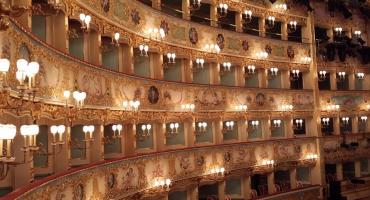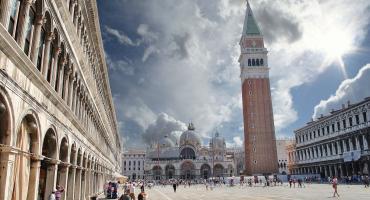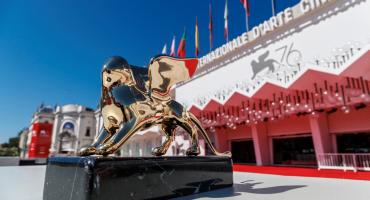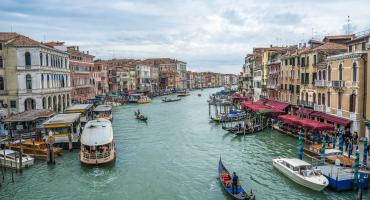For its incomparable beauty and natural sceneries that it offers, Venice has always represented a yearned and favoured scenic design for the cinematographers from all over the world that have celebrated it in all seasons through movies of different kind and depth, among the cliche of a Hallmark city and romantic decadence like a psychodrama…
For those who are keen on the seventh art, but not only, a discovery of Venice through cinema places could turn out to be an exhilarating and endless adventure whose stop-over risk to be endless…
For this reason, we have chosen only some of the most renowned place that inspired cinematographers from all over the world and we offer you a one day journey by foot or by water bus, following the traces of some of the most famous cinema sets, discovering the city through the eyes of the directors: an eternal, seductive Venice, sometimes decadent or surreal, a city that has always had an elective relationship with cinema, not only because it hosts the well known Venice International Film Festival, created by Conte Volpi, the first film festival in the world and the only one until the postwar period.

1° stop.over: (1 h) We start our itinerary getting on the waterbus number 1 from the Santa Lucia railway station, starting point to travel along the Grand Canal, the main artery of the city onto which its most beautiful palaces overlooked and from where it is possible to enjoy the most charming views and admire the symbol places for cinema.
It is in fact no coincidence, that the Grand Canal has represented one of the main open air cinema locations where have been shot some of the most wellknown movies that left a trace in the movie history of the city.
In fact, along the Grand canal we find the great Alberto Sordi in in the funny Italian comedy by Dino Risi, Venice, the moon and you (1958). In this gondolier version, with even Venetian dialect, Sordi takes young and beautiful girls on his gondola, causing the jealousy of his fiancée, who take her revenge letting her courting by the water taxi driver Nino Manfredi,
At Ca’ d’Oro some of the scenes from the movie Romeo and Juliet by Renato Castellani (1954) were shot, while near Rialto we see the finding of the corpse of the Shadows on the Grand Canal, by Glauco Pellegrini (1951), known also for his documentaries about Venice.
Along the Grand Canal overlooks the dark Palazzo Pisani from In Venice…one shocking red December (1973), psychological thriller by Nicolas Roeg in which two parents try to overcome the drama of their daughter’s death moving to a little disquieting lagoon city.
Along the Grand Canal also travel the two protagonists of Identification of a woman (1982, by Michelangelo Antonioni), who ended up at the Gritti Hotel, also theatre of the spectacular pursuits of a fascinating Roger Moore playing the role of a Venetian 007, that we find again at the end of the seventies in Moonraker by Lewis Gilbert.
It is a melancholic and twilight Venice instead, wrapped up in a perpetual fog, the one hosting the tormented love story between Florinda Bolkan and Tony Musante in the famous Venetian Anonym (1970) by Enrico Maria Salerno, whose wellknown concert for oboe by Benedetto Marcello is the soundtrack.

The scenes of the movie travel through the symbol places of the city: the Accademia, where the flashbacks of juvenile loves of the two protagonists take places, the Grand Canal, St Mark’s basin, silent spectators of the heart breaking love story unravelling through melancholic gloomy days and melodramatic scenes.
In the Church La Salute surroundings Steven Spielberg shot in 1989 Indiana Jones and the last crusade, third chapter of the series, obtaining the permit to block pedestrian traffic in order to shoot some scenes. The majesty of this church is also the background of the writer Susan Sontag's interview about the mysterious identity of Zelig in the homonymous movie (1983) by Woody Allen, who honours the city he loves by shooting here another of his works, the musical Everybody says I love you (1996), shot through the streets and the luxurious Danieli Hotel, in a charming and a bit glamorous Venice.
2° stop over: (1 h) We get off the waterbus in St Mark’s square, the heart of the city and set of the excellence of many famous movies, recreated in the recent cartoon by Pascal Morelli Corto Maltese - A ballad of the salty sea (2003).
In the Doges’ Palace they shot the movie Othello by Shakespeare, from which we remember the most two famous versions directed by Orson Welles (1952) and Franco Zeffirelli (1986). It’s a ghostly and threatening St Mark’s square the one of brutalities of a bloodcurdling Klaus Kinski, who plays the role of Nosferatu in Venice (1988) in a delirious movie by Augusto Caminito.
Walking towards Riva degli Schiavoni we come across the Bridge of Sights, another symbol of the city as well as theatre of the romantic end of another episode of 007 in which the agent take his last conquest on a gondola ride under the Bridge of sights in From Russian with Love (this time we have the handsome Sean Connery to play the part).

3° stop over: (1 h 30’) We get on the water bus again towards the island of Giudecca, place of the cinematographic offices of the Regime in 1943. here in 1983 Tinto Brass shot his famous erotic film, The Key, inspired by the homonymous novel by Tanizaki, recreating in the lagoon, in front of the Church of Redentore, a thirties Venice with even fake snow.
From here we can walk until the end of the Giudecca shore from where it is possible to see the nearby island of San Giorgio, theatre of some shots from Death in Venice, historic movie by Luchino Visconti, but we will talk about it at next stop over. In front of the island of San Giorgio, in an area of Venice that doesn’t exists any more, The canal of the angels takes place (1934), the only movie by Francesco Pasinetti, a Venetian documentary film maker, whose city has also given the title to the homonymous video archive.
Here you could take a break in the restaurant da Cip’s and, weather permitting, enjoy a pizza (cheaper than a full lunch), sitting in the most beautiful bar stallage of Venice, from which you can admire is a splendid view on San Giorgio and the lagoon in front of St Mark’s.
4° stop over: (1 h) We get on the waterbus again, back to St Mark’s square, from here we go towards the nearby Theatre La Fenice, rebuilt as it was before after the fire in 1996 that completely destroyed it. After its reopening, there are guided tours every day inside it. Admiring the stage, the balconies and the theatre’s grand staircase you cannot but live again the first scenes of the successful movie by Visconti, Sense (1954), that begins with the notes of Troubadour by Verdi.

5° stop over: (2 h) Our journey will end at Lido, a symbol of the cinema par excellence, not only because the most important Italian Film Festival takes place here, but even because in this classy atmosphere between Art-Nouveau architecture and velvet beaches, you can walk until the luxurious Des Bains Hotel, where Luchino Visconti shot some of the scenes of his famous film Death in Venice (1971).
Freely inspired by the homonymous masterpiece by Thomas Mann, the movie is shrouded in twilight and Proustian atmospheres of Lido and it tells the romantic obsession of Dirk Bogarde, an old ill musician in love with the androgynous beauty of a young boy. In the background of sitting room and terraces of Des Bains, a painful Venice as much as decadent is glimpsed, whose agony for the plague that is flaring up confusing with the agony that will lead the main character to death.
In contrast with this decadent city, background of existential crisis and love dramas, are the scenes of a recent movie by Soldini Bread and Tulips (2000) which portrays less know places of a minor Venice, funny and fairy-tale, in which the joy of living of the protagonist Licia Miglietta and its inhabitants is reflected.
Now, you could leave Lido getting on a waterbus, enjoying from it a beautiful sunset on the lagoon going back to Venice…




